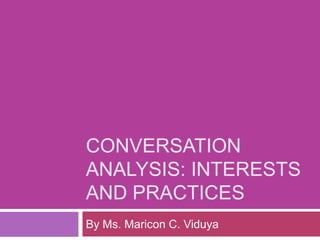
Ca ppt
- 1. CONVERSATION ANALYSIS: interests and practices By Ms. Maricon C. Viduya
- 2. Conversation Analysis a research tradition that grew out of ethnomethodology originated by Harvey Sack, Emanuel A. Schegloff, and Gail Jefferson in the late 1960s and early 1970s has become an established force in sociology, anthropology, linguistics, speech-communication and psychology particularly influential in interactional sociolinguistics, discourse analysis, and discursive psychology studies the social organization of ‘conversation’ or ‘talk-in-interaction’, by a detailed inspection of audio or video recordings
- 3. The Conversation Analyst believes that interaction is responsible for determining the nature of the relationship between people believes that social distance and power are not fixed properties but are negotiated through interaction believes that conversation/ talk-in-interaction is orderly
- 4. The main principles of conversation Conversation is a kind of activity with which people bring order to the world This activity is made up of a sequence of orderly actions (utterances) These actions as governed by rules or sets of expectations which people share with one another These rules determine things like how we begin and end conversations, who gets to talk about what and when, and how we know when it is our turn to talk and when it is not
- 5. Model of Conversation by Sack Speaker-change recurs, or at least occurs Overwhelmingly, one party speaks at a time Occurrences of more than one speaker at a time are common, but brief Transitions (from one turn to the next) with no gap and no overlap are common. Together with transitions characterized by slight gap or slight overlap, they make up the vast majority of transitions.
- 6. Model of Conversation by Sack Turn order is not fixed, but varies; Turn size is not fixed but varies; Length of conversation is not fixed in advance; Relative distribution of turns is not specified in advance; What parties say is not specified in advance. Number of parties can vary;
- 7. Model of Conversation by Sack Talk can be continuous or discontinuous; Turn allocation techniques are used. A current speaker may select a next speaker (as when he addresses a question to another party); or parties may self-select in starting a talk; Various turn-constructional units are employed; e.g. turns can be as short as a single word; and Repair mechanisms exist for dealing with turn-taking errors and violations; e.g. if two parties find themselves talking at the same time, one of them will stop prematurely, thus the trouble is repaired.
- 8. The central goal of CA research the description and explication of competencies that ordinary speakers use and rely on in intelligible, socially organized interaction
- 9. Methodological Issues Most CA practitioners tend to refrain from extensive theoretical and methodological discussion. CA papers tend to be exclusively devoted to an empirically based discussion of specific analytic issues. It is an unusual species of scientific work. It is methodologically ‘impure’ but it works
- 10. Methodological Issues does not generally have an a priori discussion of the literature to formulate hypotheses hardly any detail about research situations or subjects researched. no description of sampling techniques or coding procedures No testing No statistics
- 11. Methodological Issues Data: Recorded naturally occurring, non experimental, ordinary everyday conversation or institutional talk Data should be free from too much a product of the researcher's or informant's manipulation, selection, or reconstruction, based on preconceived notions of what is probable or important Recorded data, instead, are indefinitely rich in empirical detail, which could never be produced by the imagination of anybody.
- 12. Methodological Issues The use of recorded data serves as a control on the limitations and fallibilities of intuition and recollection The availability of an audio or video record enables repeated and detailed examination of particular events in interaction and hence greatly enhances the range and precision of the observations that can be made
- 13. Methodological Issues The use of such materials has the additional advantage of providing hearers and, to a lesser extent, readers of research reports with direct access to the data about which analytic claims are being made, thereby making them available for public scrutiny in a way that further minimizes the influence of individual preconception.
- 14. Methodological Issues The transcriptions made after these are to be seen as a convenient form to represent the recorded material in written form By making a transcription, the researcher is forced to attend to details of the interaction that would escape the ordinary listener. Transcripts provide the researcher with a quick access to a wide range of interactional episodes, that can be inspected for comparative purposes.
- 15. Methodological Issues Transcriptions should not be made with a specific research problem or hypothesis in mind. The ideal would be to have a large corpus of very detailed transcripts that can be used to locate and analyze specific phenomena. For reporting purposes one could then use selected simplified transcripts.
- 16. The CA Report a clear statement of the research issues a description of the research site, participants, procedures for ensuring participant anonymity, and data collection strategies an empirically based description of a clear and salient organization of patterns found through data analysis–including representative examples, not anecdotal information interpretations in which you trace the underlying organization of patterns across all contexts in which they are embedded a discussion of how the data analyzed in the study connect with and shed light on current theoretical and practical issues in the acquisition and use of English as an L2